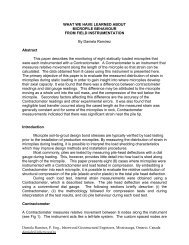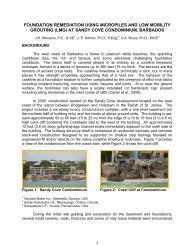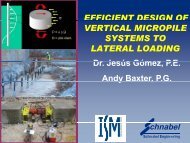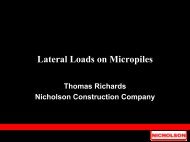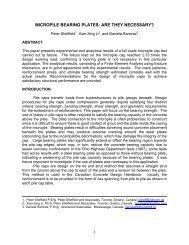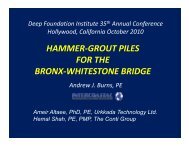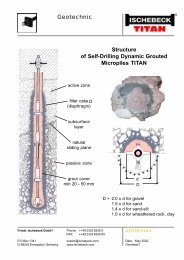Field verification Study for Micropile Load Capacity, Dr. Changho ...
Field verification Study for Micropile Load Capacity, Dr. Changho ...
Field verification Study for Micropile Load Capacity, Dr. Changho ...
You also want an ePaper? Increase the reach of your titles
YUMPU automatically turns print PDFs into web optimized ePapers that Google loves.
micropile exhibits superior stiffness and load carrying per<strong>for</strong>mance in the soil layers atthis site.According to FHWA(2005), ultimate load bearing capacity <strong>for</strong> Test Set 1 was obtainedwhen the settlement rate, dS, meets Eq. (1).dS 0.15mm/ kN(1)Figure 6 shows a direct comparison of load-displacement curves <strong>for</strong> both TAM andGPM types subjected to axial compressive loading condition. The trend line of loaddisplacementcurve was obtained via curve-fitting with exponential function given in Eq.(2).SL Ae(2)where S and L are settlement and load data set, respectively, and A and λ arecoefficients to minimize the fitting errors.Figure 6. <strong>Load</strong> vs. displacement curves <strong>for</strong> the two types of micropiles.The ultimate loads (when dS 0.15mm/ kN ) were obtained at 276kN and 590kN <strong>for</strong>TAM and the GPM, respectively. Direct comparison of the ultimate bearing load denotesthat the ultimate load of GPM is more than 200% of that of TAM. This higher bearingcapacity might be attributed to the pressurized grouting method and tight bondingquality between grout and surrounding ground. Based on the analysis of the bearingcapacity and the load transfer mechanism, it is concluded that GPM pile provides higherbearing capacity with good load transfer characteristics along the entire pile length.In order to observe the frictional resistance along micropile length, unit skin frictionwas estimated at the ultimate loading stage. Figure 7 shows the analysis results of the6
unit bond strength distribution along the depth. It is clearly identified that thecharacteristics of axial load distribution along the depth depends on the pile type. Incase of GPM, denoted with diamond marker, the unit bond strength developed highlyalong full length of the pile. However, the unit bond strength <strong>for</strong> TAM, marked as circle,is relatively much less than that of GPM. This higher friction <strong>for</strong> GPM is attributed to thepressurized grouting procedure during installation. The pressure grouting procedureenabled the grout-soil bonds to be increased and the lateral confinement of the pile tobe greater. Based on these observations, it can be inferred that GPM provides bettermicropiling technique than TAM.Figure 7. Unit skin friction along depth when ultimate compressive loading was appliedNow, the ultimate skin friction value <strong>for</strong> GPM was directly compared to SPT value atthe site. Because friction value and SPT-N are different type of properties, N-value at5m and skin friction of GPM at 4.7m are used as scaling factor asFactorNat 5m (3)fat4.7mThe unit skin friction of GPM in Figure 7 is multiplied with the factor of Eq. (3) andplotted in Figure 8 together with SPT value from the site investigation. It appears thatthe ultimate skin friction <strong>for</strong> GPM, i.e., pressure-grouting micropile, developed withsimilar trends to soil strength. In other word, GPM micropile makes the surrounding soilstrength to be fully activated upon loading. Of course, TAM result was compared to SPTvalue in the same manner, but they were not comparative.4. FIELD LOAD TEST RESULT – TEST SET 27
As described in Section 2.2, field load tests <strong>for</strong> Set 2 were per<strong>for</strong>med <strong>for</strong> GPM andTAM. Test piles were installed to bearing rock layer. It is more realistic condition <strong>for</strong> fieldapplication. From the surface, the ground condition consists of 2.8 m of sand fill, 7.8m ofsilt and sand deposit, 2.4m of weathered soil, and soft-hard rock layer.Ultimate load-bearing capacity was estimated when the head of micropiles settled25.4mm(1 inch). It was attempted to obtain ultimate bearing load using Eqs. (1) and (2),but the conditions of S 0.15mm/ kN subjected to exponential curve fitting do not locatewithin the meaningful range of loads. The ultimate bearing capacities based onS 25. 4mm criteria <strong>for</strong> GPM and TAM were 1417kN and 1188kN, respectively, asshown in Figure 9. Because the tested piles were highly slender enough to buckle at thetop, the pile heads were protected using D=50cm cap. Nevertheless, pile bucking atshallow zone occurred <strong>for</strong> both piles. Based on the test results, GPM provides 120%higher bearing capacity comparing to that of TAM. This higher resistance might beattributed to the additional friction developed in the soil layer as discussed <strong>for</strong> Set 1 testresults.Figure 8. SPT value and scaled skin friction at ultimate loading stage.8
Figure 9. <strong>Load</strong> vs. Settlement results <strong>for</strong> Test Set 24. CONCLUSIONTwo sets of field <strong>verification</strong> studies were per<strong>for</strong>med to evaluate the load bearingcharacteristics of two different types of micropiles. The two types are gravity groutingmicropile (TAM) and pressure grouting micropile (GPM). One set of load-tests verifiedthat the frictional characteristics at soil layer can be improved by aid of pressurizedgrouting method. The other set of field load tests showed GPM provides higher ultimateload bearing capacity when its tip is installed to the rock layer. Based on the two sets offield load tests, the followings can be concluded:‣ The pressure grouting micropile provides better load transfer mechanism as itmakes surrounding soil strength to be fully mobilized upon axial loading. This factmay be attributed to the better mutual bond between the grout and the surroundingground due to the step-by step pressurized construction <strong>for</strong> micropile.‣ The unit skin friction developed in pressure grouting micropile was scaled to becompared with SPT value. The result implied that the developed ultimate skinfriction varies in a similar trend to soil strength. Based on this observation, it isconcluded that the pressure grouting micropile is an appropriate micropileconstruction method.‣ Based on field load test results of Set 2, the pressure grouting method (GPM)provides at least 20% higher ultimate bearing capacity than that of the gravitygrouting method (TAM), in case the pile tips are installed to bearing rock layer.9
ACKNOWLEDGEMENTThis research was supported by a grant (06ConstructionCoreA01) from High-techUrban Development Program (HUDP) funded by Korea Ministry of Land, Transport andMaritime Affairs.REFERENCES Choi, C., Goo, J., Lee, J-H., Cho, S-D. (2008a). “Reviews on micropiling techniques”,Proceeding of Offshore and port technical group workshop, Korea GeotechnicalSociety, Seoul, Korea (written in Korean). Choi, C., Cho, S-D., Goo, J., Jeoung, J., Lee, K-H., Lee, J-H.(2008b). Foundationconstruction method of micro pile using pack used in the same, Korea Patent No.10-2008-0034653. Choi, C., Cho, S-D., Goo, J., Jeoung, J., Lee, K-H, Lee, J-H.(2008c). Foundationconstruction method of micro pile using pack used in the same, Korea Patent No.10-2008-0074010. Choi, C., Goo, J-M., Lee, J-H, and Cho, S-D. (2009), "Development of NewMicropiling Method Enhancing Frictional Resistance with Geotextile Pack",Proceeding of ISM 9 th Workshop on <strong>Micropile</strong>s 2009, London, May 2009. Fellenius, B.H. (2001), “From Strain Measurements to <strong>Load</strong> in an Instrumented Pile”,Geotechnical News Magazine, Vol. 19, No. 1, pp35-38. FHWA (2005), <strong>Micropile</strong> Design and Construction Guidelines : ImplementationManual.10




